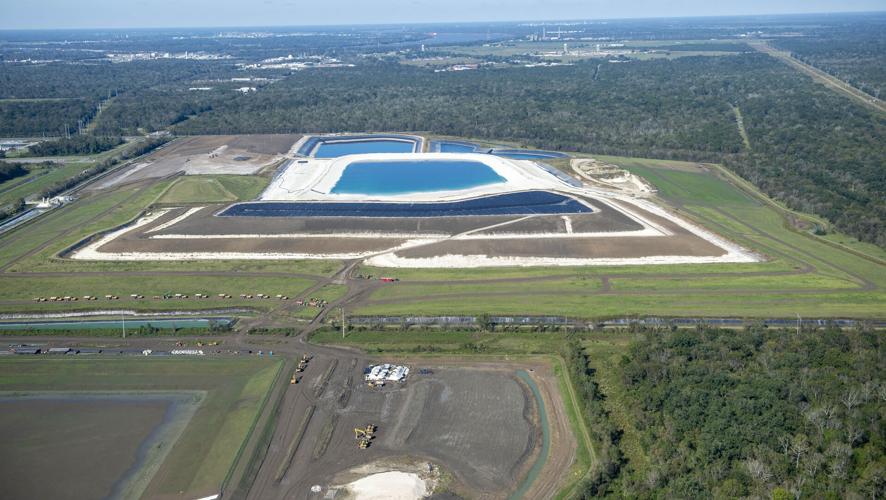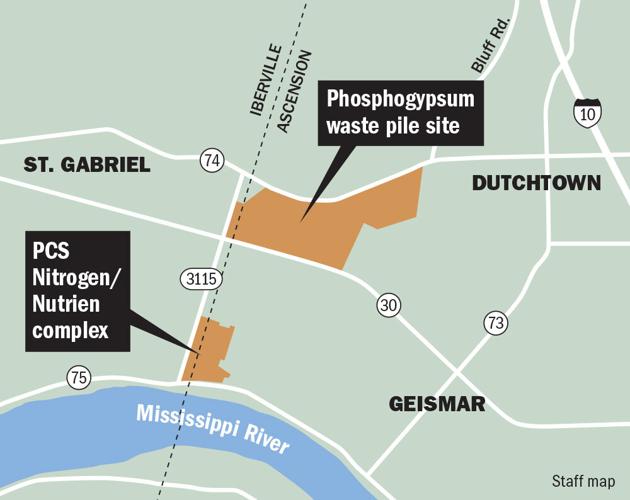GEISMAR — Since the 1960s, fertilizer manufacturer PCS Nitrogen and its predecessors have piled up a 180-foot-tall mound of a chalky white chemical waste byproduct known as phosphogypsum on a remote highway corner in Ascension and Iberville parishes.
The waste is loaded with nutrients, trace amounts of radioactive elements, heavy metals and other contaminants. And it holds 300 acres of lakes that contain an estimated 90 million to 100 million gallons of highly acidic water filled with those same contaminants.
PCS Nitrogen has been barred for decades from allowing this acidic water to escape into nearby waterways from its bright, blue elevated gypsum enclosure. But now that it is shutting down the production line that creates the gypsum, the company is seeking regulators' permission to neutralize, decant and discharge this water into the Mississippi River.
PCS Nitrogen and the state Department of Environmental Quality say the discharges would be held to federal drinking water quality standards and be quickly diluted in the vast flows of the Mississippi.

Mississippi River water usage: PCS Nitrogen is closing down a production line that produces phosphogypsum waste at its Geismar plant but needs to discharge treated acidic wastewater into the Mississippi River. Map shows parishes and populations that rely on the Mississippi for drinking water downstream of the plant.
"We are proud community members here in Louisiana and understand our responsibility to care for the environment and public health," Richard Holder, general manager of the plant, said in a statement. "This water permit from LDEQ allows us to continue to fulfill that responsibility by facilitating our completion of closure and treatment of water from our permanently shut down phosphoric acid operations and associated gypsum stacks, which will benefit the environment and community in which we operate and our employees live.”
PCS Nitrogen's plan, which is still under consideration after a public hearing and a comment period that ended earlier this month, has raised concerns among some environmental groups.
The river is the drinking water source for nearly a million people downstream, including Jefferson Parish and New Orleans, the state health department says, and tens of thousands more rely on Bayou Lafourche, which draws in river water for its flows.
Nationally, environmental groups have petitioned the U.S. Environmental Protection Agency to have the acidic water and gypsum declared a hazardous waste, ending a decades old federal exemption.
Some environmentalists worry the releases could worsen the deadzone in the Gulf of Mexico, where pollutants make water uninhabitable for marine life.
Environmental groups have called for DEQ to take a closer look at PCS Nitrogen's plans. They say the state is relying on a 35-year-old study of the river's ability to assimilate phosphorus wastes safely and, even with the nutrient reductions, the plant will remain a major input into the river in Louisiana.
The Louisiana chapter of the Sierra Club and Healthy Gulf pointed to a June 2015 letter from the EPA to DEQ when the plant's discharge permit was last renewed. The EPA noted concerns with the phosphorus standard, which imposes federal concentration limits but allows the amount of phosphorus sent into the river to rise as the river flow increases. The permit application in 2015 did not seem to address the impacts on drinking water systems downstream, the EPA added.
"In the final permit and the current draft permit, these issues have not been adequately addressed," Matt Rota and Naomi Yoder, two staffers with Healthy Gulf, and Darryl Malek-Wiley, of the Sierra Club wrote to DEQ in January of the latest permit.

Older treatment method planned
Though other fertilizer production continues, PCS Nitrogen closed down its phosphoric acid line in December 2018 that creates the gypsum and its wastewater. As a result, the company has also significantly cut its discharges of phosphorus into the river and seen nitrogen reductions.
Since that shutdown, phosphorus releases into the river fell by 50% and PCS Nitrogen expects them to fall to 22% of pre-closure levels by 2023, company officials said.
Despite the reductions, the proposed permit still allows sizeable releases of both phosphorus and nitrogen pollutants and are only moderately reduced from earlier permits or not at all. The company has also contemplated starting different production lines with unknown water discharge impacts and may reconsider them again in three to five years, permit records show.
The company wants to use a "double-lime treatment," using quick lime to neutralize the water and cause contaminants to drop out in settling ponds before it goes into the river.
The ponds, which are under construction along La. 30 and are expected to have their own air emissions, will eventually be permanently capped with the contaminants inside them.
That treatment is expected to take two to three years finish its work on the acidic lake water. But different contaminated water that gradually seeps from the pores of the huge pile also must be treated, and that is expected require 20 to 30 years, PCS Nitrogen told regulators.
Among the radioactive elements naturally in the source rock used to make phosphoric acid are radium-226, radium-228 and uranium.
After treatment of the acidic lake water, PCS Nitrogen says total radium levels would be no more than about one-fifth of the safe drinking water standard. Total alpha particles, another radioactive concern, would be higher, but still within safety limits.
Other discharge points inside the plant are expected to see radium and uranium releases as well. Uranium releases are expected to average 125 pounds per day at one internal discharge point.
It's not clear exactly what the combined rates of those contaminants will end up once they hit the river, but permit limits hold them to the federal standard.
The city of Donaldsonville and western Ascension Parish, which draw water from Bayou Lafourche just past its connection to the river, would have the closest community drinking water intake to the proposed discharges. Officials there weren't immediately able to respond.
Officials with the New Orleans Sewerage and Water Board said their system is designed to treat water that doesn't naturally have high levels of radioactive elements.
The water system doesn't have the ability test for uranium or radium, but its "treatment processes reduce uranium and radium levels in our water," said Courtney Barnes, a spokeswoman for the city utility.
State health officials, however, do test Sewerage and Water Board water for uranium and radium for safe levels, she said.
What to do?
The PCS permit raises a bigger question: What's to be done with acidic water when longtime waste piles like this one are headed toward permanent closure?
While a plant is still operational, the waste water is used and reused during phosphoric acid production to fuel creation of the acid and to deliver the waste gypsum in a wet slurry to the pile. The open air lakes collect rain in addition to the waste slurry, but the plants often use more water than the lakes store.
Once production stops, however, a major of use of the water ends, and companies must find a way to get rid of the acid water to close the pile. If the water just sits in the storage lakes, they could collapse in Louisiana wet weather, causing an uncontrolled release of the acidic water.
PCS Nitrogen has warned DEQ of just this risk.
When considering alternatives to dumping into the river, PCS Nitrogen evaluated deep well injection or hauling the water to an alternative treatment site with trucks or barges, permit records show. But the company says it couldn't find nearby locations and all those options were too costly or posed other risks.
Trucking off just the active water in the lakes would require 10 trucks per day for five years at an estimated cost of $86 million, PCS Nitrogen told regulators.
That's enough water to fill 136 to 151 Olympic-sized swimming pools.
Double-lime treatment, by contrast, is expected to run around $20 million.









